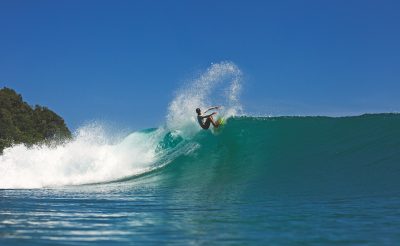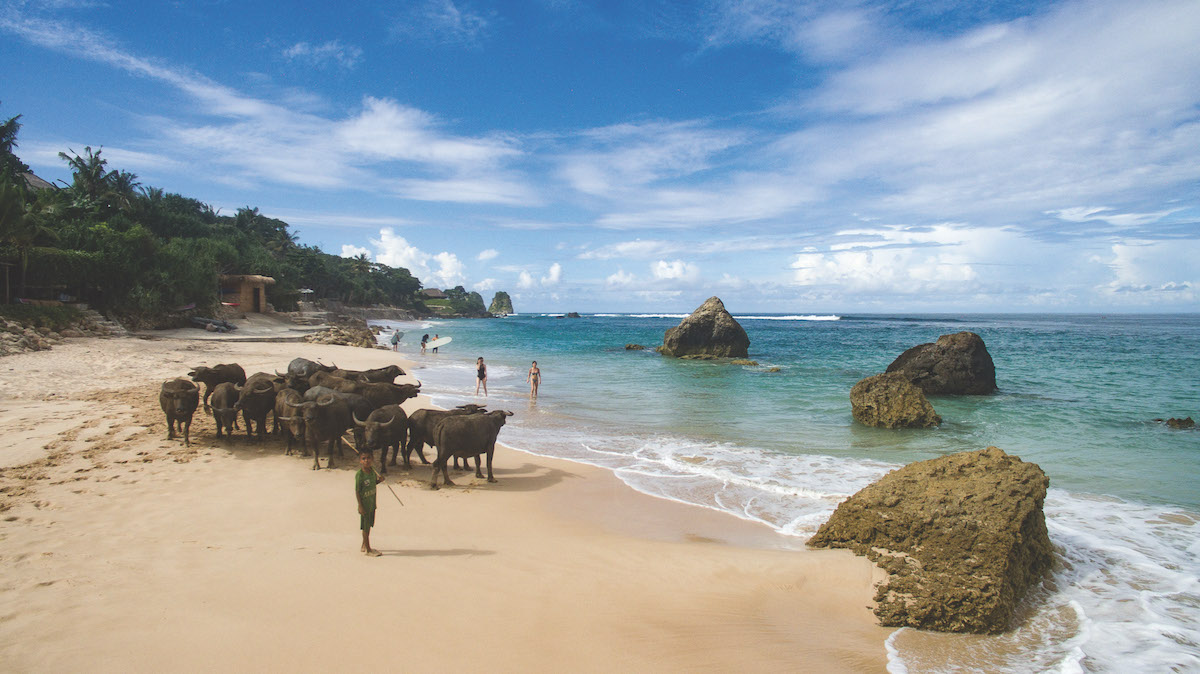The world’s best surfing hideaway is in Indonesia

On both sides of me, as far as my eyes can see, there’s nothing but rugged, empty coastline and undulating forest. There was a time when Bali looked like this. Long before the gridlocked traffic, the Bintang singlet salesmen of Kuta Beach, and the $10 antioxidant almond smoothies in Seminyak that come delivered direct to your lounge pods by Balinese dudes with hair-buns.
The waves in Bali all used to break just like this too: perfectly spaced ocean swells from the south, heaving northward, exploding with handsome fury onto deserted reefs close to shore; the water so clear you could see every fish, on every coral head, swimming hard to avoid the approaching cacophony of white water.

I’m watching a clean line of ocean swell as it pushes hard across an empty bay. We’re a couple of hundred metres from the shore in a small runabout. When the skipper turns the outboards off, there’s dead silence. As the ocean swell ends its long journey up from the Southern Ocean and into the Indian Ocean with a crash onto the reef, a dull roar breaks the quiet, and flecks of whitewash swoop back towards us, catching the sunlight and making a rainbow.
How's the serenity
Surf guide Kyle Collins surveys the countryside, then points shoreward: "Drive for three hours that way and there’s nothing but a few shacks by the road," he says with a shake of his head. He’s from Ventura – around those congested parts of southern California no-one rides a wave solo; these lonely waves breaking among all this lovely nothingness must mess with his idea of a happy wave-riding childhood.
We’re sitting watching an assembly line of Indian Ocean screamers break barely 100 metres from us, yet we’re taking our time, breathing it all in, committing every moment to memory so we can recall this anticipation. Anyway, there’s no surfer within 200 kilometres of us, so no-one’s stealing this beautiful ride. Kyle is first to jump. I watch him submarine beneath the blue of the surface.
We paddle across the reef, and when the first wave comes, Kyle offers it up, and I study the set-up for a moment before I begin my ride. This is a perfectly formed clear cylinder of ocean breaking over a shelf of living, breathing coral. Waves weren’t meant to break quite so sweetly, and as I jump to my feet, all I see is an exquisitely formed crest of water that doesn’t break too far in front of me but instead propels me forever forward, like I’m on an amusement park ride that’s set to go exactly this way every time.
Endless perfect, empty waves
And the most remarkable detail about this wave I’m riding is that it isn’t even what I came here for. This wave is nothing but a ‘back-up’, a ‘spare’ wave, just around the headland from what surfers come all this way for – Occy’s Left, the famed left-hand reef break that breaks with almost robotic regularity directly in front of one of the world’s most revered resorts, Nihiwatu.
Most visitors won’t even see the wave I’m surfing – because Occy’s Left (named after former world champion Mark Occhilupo, whose surfing here in the movie Green Iguana cemented the wave’s lofty reputation) is enough to satisfy any surfer on earth. It’s widely regarded as the best wave in Indonesia, and that’s saying something.
But that’s how it works here on the island of Sumba – 45 minutes flying time from Bali. There are umpteen perfect, empty waves here going unridden as you read this; and these days if you want to surf like it’s 1975, you have to leave Bali far behind and get to islands like this one.
Not just a surfer's retreat
Nihiwatu epitomises the surfer’s dream, and then some. I’ve seen this place many times from the sunset bar tucked into the rocks and pandanus trees beside a horseshoe-shaped beach where guests drink sundowners after washing in from surf sessions, to the barefoot sand-floored restaurant where each morning guests gorge on pawpaw and mango as they watch waves roll in from the horizon.
No surf retreat is built in a better setting anywhere on planet earth – I love falling asleep in my villa at night as the moonbeams shine across the water in front of me – yet these days, there are as many non-surfers staying at Nihiwatu as surfers. It’s impossible to call Nihiwatu just a surfer’s retreat these days.
That says a lot, I guess, about who’s in charge now. Self-made fashion billionaire Chris Burch and American hotelier James McBride took over ownership of Nihiwatu five years ago, and while the surfers never stopped coming, the non-surfers began their pilgrimage east from Bali.
Burch and McBride helped oversee a recreational program that took guests beyond the wave and onto horseback for rides along the beach, into a chocolate-making factory, into the surrounding villages, hiking to remote waterfalls, or paddle boarding down riverways through ancient forests.
Luxury on the edge of wildness
Now, this tale could be a sorry one – for Nihiwatu was the dream of a wanderlust couple who scoured the globe looking for the perfect wave (they found it here on the remote southern coast of Sumba in 1988, and devoted the next 24 years to building the ultimate surf retreat) – but it’s not, because what it was that made Nihiwatu world renowned in the first place has never been compromised.
Nihiwatu may well be a five-star resort with a five-star price tag – and it may have been voted by readers of US travel bible Travel + Leisure as the ‘Top Destination Hotel Resort in the World’ in 2016 – but it doesn’t feel that fancy.
There’s no pomp or ceremony. There’s sand on the floor of the Ombak Restaurant, and it has a massive thatched roof in the local community style. I never wear anything fancier than thongs, shorts and a T-shirt to dinner. When I arrive – after an hour-and-a-half journey through the dry, dusty villages of southern Sumba perched on seats built on the back of an open 4WD – I find a jungle lodge balanced on the edge of a wilderness long gone in Bali (the resort markets itself as ‘Luxury on the Edge of Wildness’).
The people of Sumba – Indonesia’s poorest island – still practise ancient sorcery, and Nihiwatu evokes a sense of wild tribalism while still feeling like a refuge from the elements. There are monitor lizards as tall as my girlfriend, sunning themselves on the back steps of our villa, but there’s also a garden that smells of jasmine, and a butler on call 24 hours a day for anything we could possibly need.
Horse-induced thrills
For all its surfing kudos (and there are only 10 surfers allowed in the water on any given day; can you even imagine that?) I find it’s the activities on offer outside the ocean that are just as memorable. There’s a professional equestrian centre, Sandalwood Stables, beside the resort, and one evening I ride a horse along the 2.5-kilometre beach Nihiwatu is built on. My guide allows me to ride as fast as I want and, as the sun sets in a blaze of burnt orange, my tough little Sumbanese horse takes off at a gallop along the water’s edge.
My heart feels like it might leap right out of my chest; all I hear is the sound of it frantically beating blood to my brain mixed with the frenetic drumbeat of my horse’s hooves forging a path along the hard sand by the high-water mark. I’m lost entirely in this moment, I can’t even begin to fathom this high – and I know if I analyse this moment later on, I won’t ever be able to recreate it entirely in my mind.
So I go with it now for all it’s worth (for a different kind of horse-induced thrill, you can also ride a wakeboard in the shallows as a horse runs on the beach beside you). Next day I walk with a local guide through nearby villages, past families washing in creeks and locals toiling in rice paddy fields to Nihiwatu’s remote day spa, Nihi Oka, set on a tiny headland between two private sandy bays.
Fare for foodies
I swim in the ocean; then, atop a tree platform overlooking the sand, I have a breakfast cooked on a wood fire by a private chef, before spending the next two hours in a private bale on the cliff tops, choosing between massages, body scrubs and facials. Lest I miss the sight of the ocean – though I can hear it all so clearly roaring from where I lie – there’s a mirror on the floor beneath the hole in my massage chair so I can gaze out across the blue expanse.
Though most days I’m quite content to wander within the confines of Nihiwatu’s glorious 230 hectares, occasionally taking in a yoga class in a hillside treehouse high above the ocean, or more often ambling slowly from my villa to the restaurant or the bar. For all its excursions and activities, Nihiwatu is also the home of the two-hour breakfast and the three-hour lunch, interspersed with morning and afternoon tea.
There’s the sandy Ombak Restaurant with its views out over the world, or the Nio Beach Club & Pool where the sea almost reaches your open-air table, out beside the horizon pool. There are three organic gardens on site; most choices on the menu use nothing but locally sourced products in dishes invented by Australian head chef Ben McCrae. Though for all his ingenuity, I struggle to go past the simple yellow-fin tuna sashimi burrito on the menu at the Nio Beach Club & Pool – made with tuna caught that same morning by guests on a fishing expedition.
A sense of community
There’s a camaraderie here among the guests that I don’t feel all too often in my travels. In a place so far removed from what we all know, perhaps there’s a sense of community that comes from seclusion and living out here on the edge of all this wildness.
There’s a renowned writer here while I stay, and a well-regarded DJ from Los Angeles, but regardless of status and bank accounts, guests mix freely, especially at occasions like the weekly seafood barbecue at Ombak Restaurant where communal dining is encouraged. Or over cocktails at the Boathouse as day turns to night, or over waves shared at Occy’s Left – the best most of us will ride in a lifetime.
I like, too, that Nihiwatu doesn’t operate as its own selfish, Western-world entity, but rather as a part of the community in which it’s located. Nihiwatu is the biggest employer on the island – and money goes back to the villages through the Sumba Foundation that the resort helps fund to develop health, education, water, and malaria-eradication projects. Unlike some other parts of Asia, staying five-star here doesn’t have to feel like a trip back to old colonial days.
There’s a fresh spike of swell forecast for the morning I must leave Nihiwatu, and as I watch lines of waves from the Southern Ocean hit the reef, creating perfect cylinders that might have been drawn by the bored adolescent version of me in the pages of my high school exercise books, I think about surf guide Kyle and wonder what it must be like to have nowhere to go but these hundreds of hectares of surfing Nirvana out here on the borders of civilisation.
Villas start from US$1,000 per night (plus taxes).
Exclusive offer to Australian residents: all villa rates in US$ are matched to AU$ until 31 December 2017. Head to nihiwatu.com for more info.